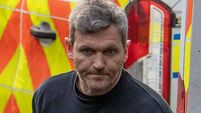Commoner Tom Crean’s heroism went almost unnoticed

A CENTURY ago today, three men — Ernest Shackleton, Frank Worsley, and Tom Crean — stumbled into a whaling station at Stormness on the island of South George in a pitiful condition. They had not washed for months. Their faces and hands were black from blubber smoke, their hair and long beards were matted, their clothes were in rags.
Their experiences were among history’s greatest survival and rescue stories in the most trying conditions, extending not just over hours, days, or weeks, but months.
















